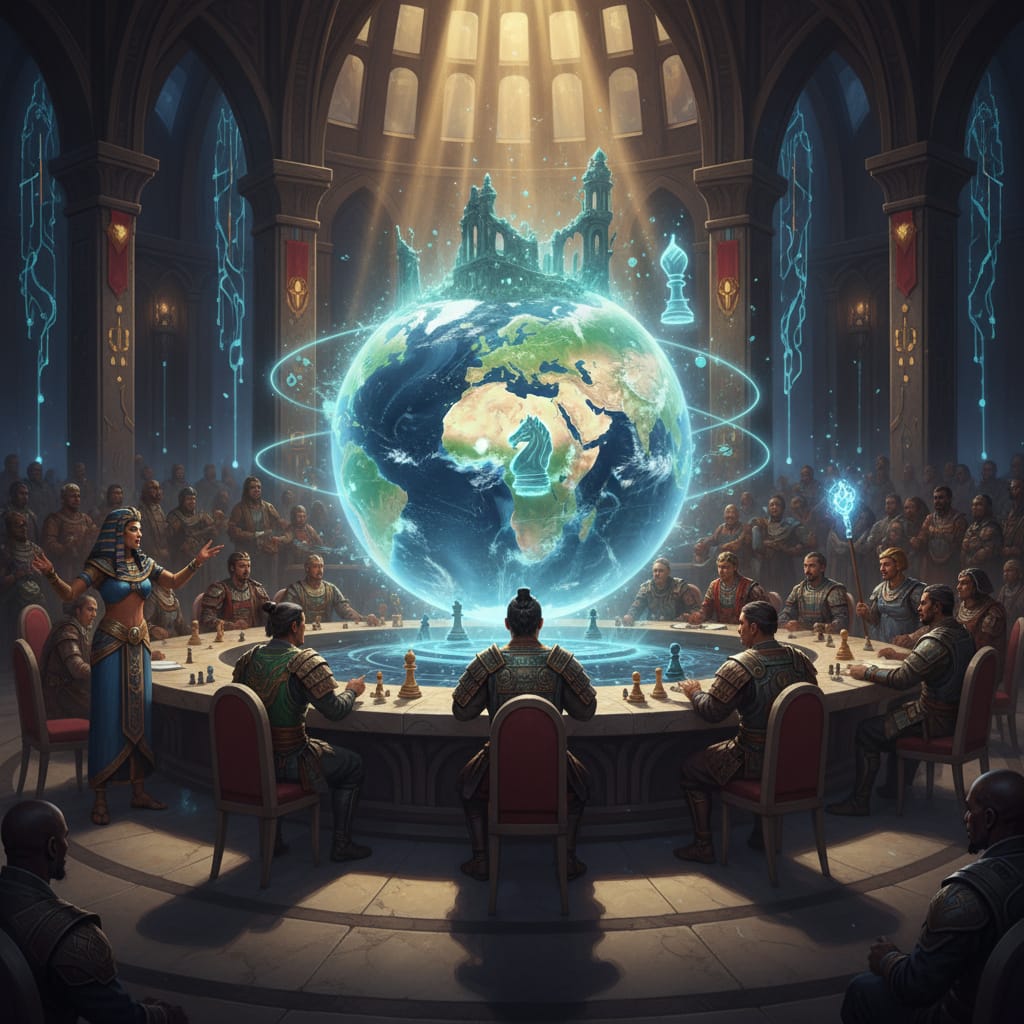The late game of Civilization VI is often a tense affair, a chessboard of sprawling empires vying for the last few, precious victory points. Borders are hardened, ideologies have been chosen, and the world map is a stark representation of the victors and the vanquished. But what if the fallen could rise again? Imagine a World Congress session, not to ban a luxury resource or sanction a warmonger, but to debate the very existence of a fallen empire. The proposition: to resurrect a civilization that was wiped from the pages of history. This isn’t merely a question of bringing a player back into the game; it’s a strategic earthquake with the potential to redefine the global balance of power, creating new allies, new enemies, and a fresh layer of diplomatic chaos. Analysis on forums shows that while the current game allows for a form of resurrection through city liberation, a formal World Congress resolution would introduce a far more complex and politically charged dimension to this concept.
The Mechanics of Rebirth: A World Congress Resolution
For this hypothetical scenario to be more than just a flight of fancy, it needs a solid mechanical foundation. A popular strategy is to consider how existing game systems could be adapted. The resurrection of a dead civilization would likely be a special resolution, appearing only after a civilization has been completely eliminated from the game.
Triggering the Vote
According to the player community, the most logical trigger for a resurrection vote would be the elimination of a civilization. Once a civ is wiped out, a specific grievance could be generated against the conquering civilization, “Extinction of a People,” which would be a permanent, high-level grievance. After a set number of turns, perhaps 20 or 30, a special session of the World Congress could be called to address this.
The resolution itself would be straightforward: “Vote to restore the [Civilization Name] to the world.” The options would be a simple “Aye” or “Nay.” The cost to vote would, of course, be Diplomatic Favor, and the civ that was responsible for the elimination would likely face a higher cost to vote “Nay,” reflecting the international pressure against them.
The Price of a Soul: Diplomatic Favor and Gold
Many professional gamers suggest that resurrection shouldn’t be a simple matter of casting votes. The process should be costly, reflecting the monumental task of rebuilding a fallen nation. A successful “Aye” vote would not instantly bring the civilization back. Instead, it would trigger a project in the cities of all “Aye” voters: “Fund the Restoration.”
This project would require a significant amount of Gold and Production, with the total amount determined by the era and the size of the fallen civilization. Each “Aye” voter would contribute to a shared pool, and once the target is reached, the civilization would be reborn. This creates a fascinating dynamic: a civilization could vote “Aye” for the diplomatic clout but then contribute little to the actual restoration, hoping others will bear the financial burden.
The Rebirth: A Phoenix from the Ashes
The resurrected civilization would not simply reappear in its former glory. It would be a shadow of its former self, a fledgling state struggling to survive in a world that has moved on without it.
The New Capital and Borders
The resurrected civilization would reappear with its original capital, which would be ceded from its current owner. This in itself is a massive strategic implication. The current owner of the capital would have a huge incentive to vote “Nay” and to pressure others to do the same. If the vote passes, they would lose a city, likely a well-developed one, without any compensation other than the removal of the “Extinction of a People” grievance.
The resurrected civ would start with a small amount of territory around its capital, perhaps a three-tile radius. It would have a handful of basic units: a Settler, a Builder, and a few military units from the current era. It would be a fragile entity, a city-state with the potential to become a full-fledged empire once more.
Technology and Civics: A Blank Slate
A popular strategy is to consider the technological state of the resurrected civ. It would not retain its previous scientific or cultural progress. Instead, it would be granted a “catch-up” bonus, a significant boost to its Science and Culture per turn for a set number of turns. This would allow it to quickly climb the tech tree and become relevant again, but it would still be significantly behind the major powers. The level of this boost could even be a point of negotiation in the World Congress, with different levels of aid being proposed.
The Strategic Implications: A New Player on the Board
The resurrection of a dead civilization would send ripples across the globe, forcing every player to reassess their strategies and alliances.
The Diplomatic Game: A New Ally or a Vengeful Foe?
The resurrected civilization would have a unique diplomatic relationship with the rest of the world. It would have a massive, permanent positive relationship modifier with all civilizations that voted “Aye” and contributed to its restoration. This could instantly create a new, loyal ally, a “client state” that could be a reliable voting partner in the World Congress and a military ally in times of war.
Conversely, it would have a permanent, high-level grievance against the civilization that destroyed it. This would create a new, permanent enemy for the conquering civ, a thorn in its side that could harass its borders, spy on its cities, and vote against it in the World Congress.
The Economic Game: A New Market and a New Competitor
The resurrected civilization would be a new market for trade routes, a new source of luxury resources, and a new competitor for Great People. Civilizations with strong economies could profit from the restoration, sending traders to the new capital and selling luxury resources to the fledgling state.
However, the resurrected civ would also be a new competitor. It would be vying for the same resources, the same city-state allegiances, and the same victory points as everyone else. This could lead to new conflicts and new rivalries, especially as the resurrected civ begins to expand its borders and exert its influence.
The Military Game: A Proxy War and a Strategic Buffer
The resurrected civilization would be a weak but strategically significant military player. It could be used as a proxy in wars between major powers, with each side vying for its allegiance. A civilization could fund the resurrected civ’s military, sending it gold and resources to build up its army, and then use it to attack a common enemy.
The resurrected civ could also serve as a strategic buffer between two larger empires. A civilization could vote to resurrect a civ on its border, creating a neutral zone that would protect it from a powerful neighbor. This would be a risky move, as the resurrected civ could eventually become a threat itself, but it could be a powerful defensive strategy in the short term.
The Dark Side of Resurrection: Exploitation and Extortion
The ability to resurrect a dead civilization would not be without its dark side. Cunning players would find ways to exploit this new mechanic for their own selfish ends.
The “Puppet Master” Strategy
A popular strategy is to consider how a powerful civilization could use resurrection to create a permanent puppet state. A player could intentionally allow a weaker neighbor to be conquered, only to then lead the charge to resurrect it. The resurrected civ would be eternally grateful, a loyal vassal that would do its bidding without the need for a formal declaration of war or a military occupation. This “Puppet Master” strategy would be a powerful tool for diplomatic and economic domination.
The “Extortion” Strategy
Analysis on forums shows that the threat of resurrection could be used as a form of extortion. A civilization that has just conquered another could be faced with a World Congress resolution to resurrect its victim. To avoid this, the conquering civ could be forced to make concessions to the other major powers, offering them gold, resources, or even cities in exchange for a “Nay” vote. This would create a new layer of blackmail and intrigue to the diplomatic game.
A More Dynamic and Unpredictable World
The introduction of a World Congress resolution to resurrect a dead civilization would be a game-changer for Civilization VI. It would add a new layer of strategic depth and diplomatic complexity to the late game, transforming the world from a static map of victors and vanquished into a dynamic and unpredictable landscape of shifting alliances and sudden reversals of fortune. The fallen would no longer be a footnote in history; they would be a constant presence, a ghost at the negotiating table, a potential ally or a vengeful foe waiting for its chance to be reborn. The world of Civilization VI would be a more dangerous, more exciting, and more interesting place. The question would no longer be just “who will win?”, but also “who will be brought back from the brink?”.


